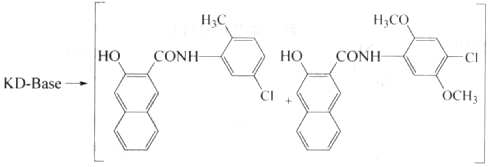Pigmento rojo 184
| nombre del producto | PIGMENT RED 184 |
| Sinónimos | C.I.Pigment Red 184;C.I.PR184; PR184; P.R.184 |
| CI | 12487 |
| NO CAS. | 99402-80-9 |
| Peso molecular | 565.02 |
| Fórmula molecular | C32H25ClN4O4 |
| Color | Polvo rojo |
![]()
Fórmula de estructura molecular:

Fastness Properties of Pigment Red 184:
| Resistencia a la luz | 4-5 |
| Resistencia al calor (℃) | 180 |
| Resistencia al agua | 5 |
| Resistencia al aceite | 5 |
| Resistencia ácida | 4-5 |
| Resistencia a los álcalis | 4-5 |
| Resistencia al alcohol | 4 |
Aplicación principal: Tinta a base de agua, Tinta offset, Tinta a base de solvente, Plástico, Pintura, Impresión textil
Tenemos varios grados y propiedades de pigmentos para satisfacer las necesidades de los diferentes clientes; especifique su aplicación y requisitos para que podamos recomendarlos en consecuencia. Correo electrónico: sy@sypigment.com
Product Description of Pigment Red 184:
Pigment Red 184 is similar to CI Pigment Red 146 in terms of shade, application performance and chemical structure. It is a modified product of CI Pigment Red 146. It is mainly used for printing inks. Its samples are resistant to soap, paraffin, dibutyl phthalate, Toluene, etc.; light fastness is one level higher than CI Pigment Red 57:1; excellent solvent resistance makes it suitable for all kinds of printing inks, such as packaging printing inks, flexographic printing inks and metal decorative printing inks, and the heat stability is 170℃/10min
Pigment Red 184 is a blue shade, semi-transparent Naphthol AS pigment. It meets the requirements for the EUropean Scale for Process printing. It exhibits food allround fastness properties and is an alternative for Pigmento rojo 57: 1 pigments, if their fastness properties are not good enough. Recommended for paste inks as well as for solvent- and water-based packaging gravure and flexographic printing inks.
TDS (Pigment Red 184) MSDS (Pigment Red 184)Sinónimos
- Pigmento rojo 184
- 67990-05-0
- 99402-80-9
- N-(5-CHLORO-2-METHOXYPHENYL)-3-HYDROXY-4-[[2-METHOXY-5-[(PHENYLAMINO)CARBONYL]PHENYL]AZO]NAPHTHALENE-2-CARBOXAMIDE
- N-(5-chloro-2-methoxyphenyl)-3-hydroxy-4-[[2-methoxy-5-(phenylcarbamoyl)phenyl]diazenyl]naphthalene-2-carboxamide
- 2-Naphthalenecarboxamide, N-(5-chloro-2-methoxyphenyl)-3-hydroxy-4-[[2-methoxy-5-[(phenylamino)carbonyl]phenyl]azo]-
- N-(5-Chloro-2-methoxyphenyl)-3-hydroxy-4-((2-methoxy-5-((phenylamino)carbonyl)phenyl)azo)naphthalene-2-carboxamide
- 2-Naphthalenecarboxamide, N-(5-chloro-2-methoxyphenyl)-3-hydroxy-4-((2-methoxy-5-((phenylamino)carbonyl)phenyl)azo)-
- SCHEMBL305980
- DTXSID0070942
- EINECS 268-028-8
- AKOS032949945
- ZINC103842522
- EC 268-028-8
- H11635
- 402P809
- 2-Naphthalenecarboxamide, 3-hydroxy-4-((2-methoxy-5-((phenylamino)carbonyl)phenyl)azo)-N-(2-methoxy-5-chlorophenyl)-
- 2-Naphthalenecarboxamide, 3-hydroxy-4-((2-methoxy-5-((phenylamino)carbonyl)phenyl)azo)-N-(5-chloro-2-methoxyphenyl)-
- 2-Naphthalenecarboxamide, N-(5-chloro-2-methoxyphenyl)-3-hydroxy-4-(2-(2-methoxy-5-((phenylamino)carbonyl)phenyl)diazenyl)-
Nombre IUPAC: N-(5-chloro-2-methoxyphenyl)-3-hydroxy-4-[[2-methoxy-5-(phenylcarbamoyl)phenyl]diazenyl]naphthalene-2-carboxamide
InChI: InChI=1S/C32H25ClN4O5/c1-41-27-15-13-21(33)18-25(27)35-32(40)24-16-19-8-6-7-11-23(19)29(30(24)38)37-36-26-17-20(12-14-28(26)42-2)31(39)34-22-9-4-3-5-10-22/h3-18,38H,1-2H3,(H,34,39)(H,35,40)
InChIKey: IBHCUBFBUGYOHF-UHFFFAOYSA-N
SONRISAS canónicas: COC1=C(C=C(C=C1)Cl)NC(=O)C2=CC3=CC=CC=C3C(=C2O)N=NC4=C(C=CC(=C4)C(=O)NC5=CC=CC=C5)OC
| Nombre de la propiedad | El valor de la propiedad |
| Peso molecular | 581 |
| XLogP3-AA | 7.4 |
| Recuento de donantes de enlaces de hidrógeno | 3 |
| Recuento de aceptores de enlaces de hidrógeno | 7 |
| Recuento de bonos giratorios | 8 |
| Masa exacta | 580.1513476 |
| Masa monoisotópica | 580.1513476 |
| Área de superficie polar topológica | 122 Ų |
| Recuento de átomos pesados | 42 |
| Cargo formal | 0 |
| Complejidad | 933 |
| Recuento de átomos de isótopos | 0 |
| Recuento de estereocentros de átomos definidos | 0 |
| Recuento de estereocentros de átomos indefinidos | 0 |
| Recuento de estereocentros de enlaces definidos | 0 |
| Recuento de estereocentros de enlace indefinido | 0 |
| Recuento de unidades unidas covalentemente | 1 |
| El compuesto está canonizado | Sí |




